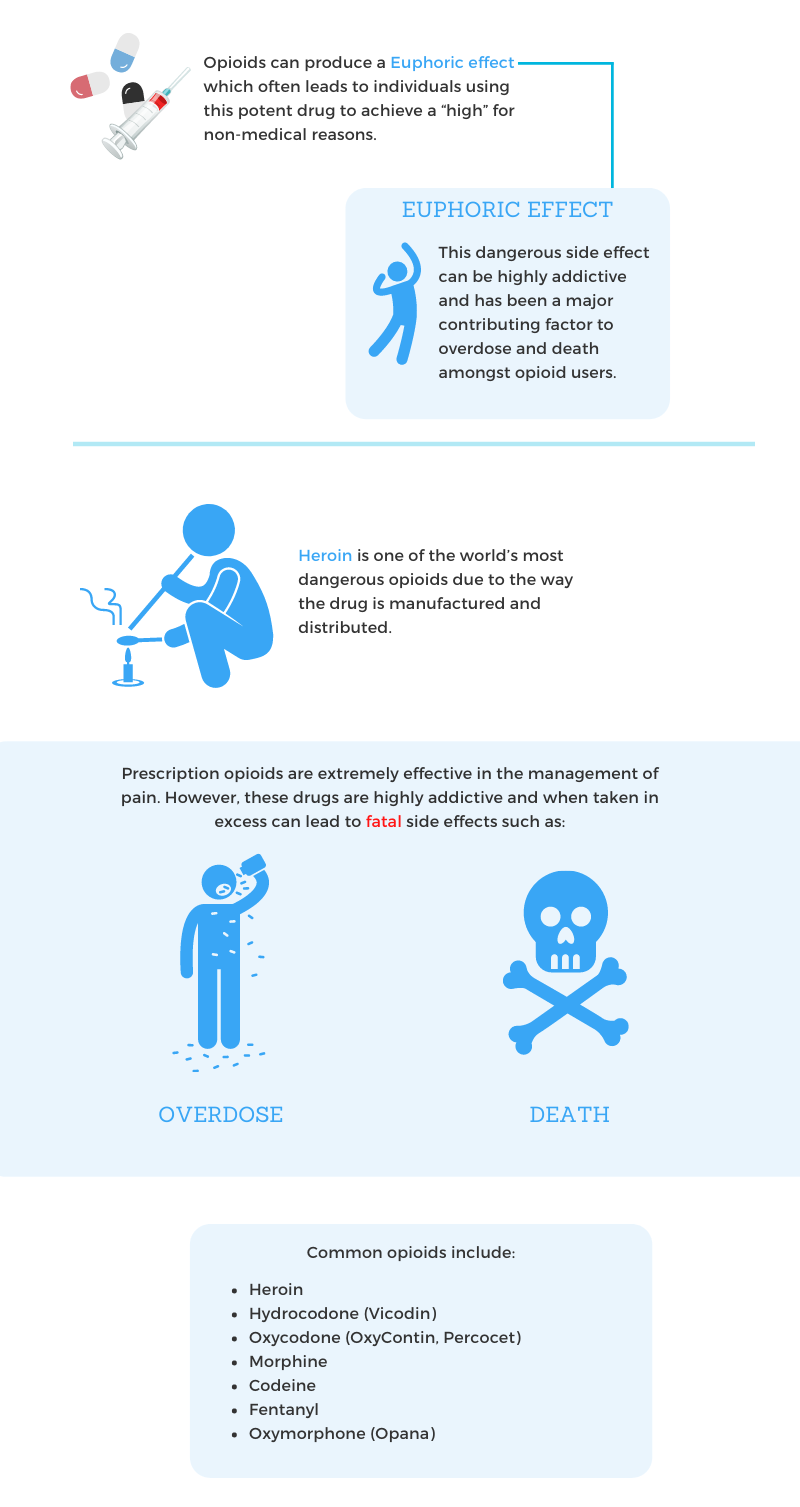Opioids are a class of drugs that include prescription painkillers, synthetic fentanyl, and even heroin. According to the Mayo Clinic, an estimated 5 to 8 million Americans use opioids for chronic pain. Furthermore, prescription opioids have become the most abused class of drugs in the U.S. While statistics show the staggering numbers of the opioid epidemic plaguing our country, the side effects of opioids range from a variety of harmful consequences. Opioids are easy to acquire, readily prescribed, and highly addictive.
Are Opioids Harmful?
Opioids are a class of drugs that are naturally derived from the opium poppy plant. Some prescription painkillers are derived from the plant while others are synthetically composed in labs utilizing the same chemical structure. Opioids are often manufactured as pain medications in order to treat moderate to severe pain. Some opioids are used to treat coughing and diarrhea.

Side Effects of Opioid Use
Prescription opioids are used for the treatment of moderate to severe pain and treatment is generally safe when taken as prescribed for a short period of time. However, this class of drugs is highly addictive and can be misused. If an individual misuses the prescription by taking it in a way or dose other than prescribed, taking someone else’s prescription medication, or taking the medication to achieve a “high” – the risk of experiencing harmful side effects is much greater. Individuals who abuse opioids may take the medication in a way that is not prescribed by either crushing, snorting, and even injecting the drug into their veins. When misusing opioids an individual may face several damaging side effects.
Opioids bind and activate opioid receptors on cells located throughout the brain, spinal cord, and other vital organs within the body. This interaction blocks pain signals to the brain and body, creating an influx of dopamine and a euphoric effect.
Other common side effects of opioid use include:
- Tolerance
- Physical dependence
- Increased sensitivity to pain
- Constipation
- Drowsiness
- Confusion
- Nausea/vomiting
- Dry mouth
- Sleepiness
- Dizziness
- Anxiety
- Depression
- Low testosterone (leads to changes in sex drive, energy, strength)
- Change in appetite
- Itching
- Sweating
- Slowed breathing
- Respiratory depression
- Change in mood
- Kidney disease
- Overdose/Death
Opioid Dependence and Addiction
Individuals who use opioids over an extended period of time pose the risk of developing a physiological dependence on these potent drugs. Dependence on opioids is related to an individual experiencing withdrawal symptoms when they attempt to stop using the drug. One of the associated risks of taking prescription opioids is the physical dependency component. An individual who is taking opioids over an extended period of time is likely to experience withdrawal symptoms if they quit taking the prescription.
Uncomfortable withdrawal symptoms can lead the user to continue using the drug despite negative consequences. It is surprisingly easy for an individual to experience opioid addiction without even realizing it is happening. Addiction is a disease but can be a direct result of taking a medication for an extended period of time. Once the individual becomes dependent on opioids and is unable to stop, despite negative consequences, he/she is likely to experience negative consequences with their health, relationships, employment, finances, and almost every other area of their life. According to the Centers for Disease Control (CDC), as many as 1 in 4 patients receiving long term opioid treatment struggles with opioid addiction.
Overdose
Statistics reveal that more than 130 people die every single day from an opioid overdose in the U.S. Opioid overdose is not always easy to detect. Often times an opioid user may seem heavily under the influence, when in fact they are experiencing an overdose. The best way to determine if someone is experiencing an opioid overdose is to educate yourself on how to tell the difference.
Signs of opioid overdose:
- Loss of consciousness
- Unresponsive to stimuli
- Awake but unable to speak
- Bluish purple or grayish/ashen skin color
- Vomiting
- Slow, shallow, erratic breathing
- Limp body
- Face is pale or clammy
- Choking sounds
- Snore-like gurgling noise (death rattle)
- Fingernails and lips turn blue, purple, or black
- Slow, erratic, or no pulse
If you or someone you know is experiencing an opioid overdose, it is absolutely important that you immediately call 9-1-1 for help!
Opioid Withdrawal Treatment
Opioid withdrawal can be extremely uncomfortable and almost impossible to mitigate on your own. Withdrawal symptoms often include:
- Muscle and bone pain
- Hypersensitivity to pain or discomfort
- Flu-like symptoms
- Chills
- Cold sweats
- Vomiting
- Diarrhea
- Restless Leg Syndrome
- Loss of appetite
- Depression/anxiety
- Inability to sleep
- Severe cravings
These painful side effects of opioid withdrawal often lead a user to continue using in order to avoid the withdrawal process. However, successful substance abuse treatment often includes a medically supervised detoxification process to maximize comfort and safety. An effective strategy for the treatment of opioid addiction is medication-assisted treatment (MAT). This method of treatment includes medication and therapy. The medications used treating opioid disorders help patients mitigate withdrawal symptoms in order to attend counseling sessions and undergo therapy to discuss the root of their addiction. Behavioral therapies for prescription opioid addiction can also set a solid foundation for individuals in recovery to adjust their perceptions, attitudes, and behaviors, in order to maintain continuous sobriety.











